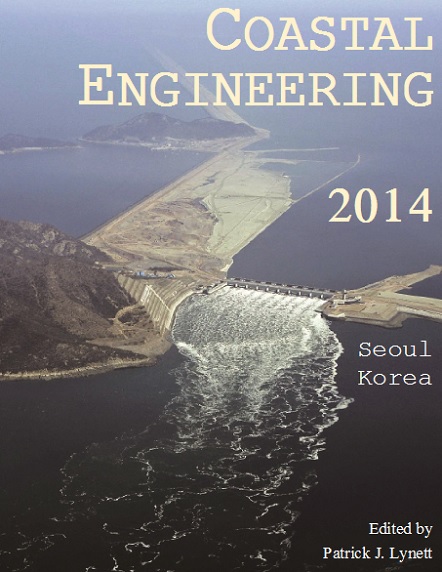Abstract
Offshore wind farms in coastal areas are considered by the Danish government to contribute to the goal of having 50% of the energy consumption from renewable sources by 2025. Therefore, new coastal developments will take place in Danish areas. The impact of waves on atmosphere is most often described by roughness length, which is typically determined by the Charnock formulation. This simplification in many atmospheric models has been shown to bring bias in the estimation of the extreme wind. Some wave-dependent formulations have been reported to overestimate the drag coefficient and roughness, but new roughness formulations have been proposed to better estimate wave-wind interactions according to observations. In the present work, an assessment of several roughness descriptions is performed, and implications for coastal wind and wave modelling are studied. An atmospheric (WRF) and spectral wave model (MIKE 21 SW) are implemented for the North Sea in order to consider wave effects on roughness. The objective is to see the reaction of an atmospheric model to the water surface description through offline coupling. A comparison with three simplified roughness formulations embedded in WRF showed a 50% variation in roughness and 20% in wind, with the better formulation for wind leading degraded predictions of roughness compared with observations. The large estimates of roughness when using a 3rd generation wave model are evident offshore, while a roughness formulation based on wave age produces more realistic values. However, at a coastal site, both estimates were within the same range. The impact of roughness on the wave model is discussed in terms of an idealized case for fetch-limited wave growth.References
Bidlot, J., Janssen, J.P.F.M., Abdalla, S., 2005. A revised formulation for ocean wave dissipation in CY29R1, Internal Memorandum Research Department. ECMWF, Reading.
Davis, C., Wang, W., Chen, S.S., Chen, Y., Corbosiero, K., DeMaria, M., Dudhia, J., Holland, G., Klemp, J., Michalakes, J., Reeves, H., Rotunno, R., Snyder, C., Xiao, Q., 2008. Prediction of landfalling hurricanes with the advanced hurricane WRF Model. Monthly Weather Review 136, 1990-2005.
Chao, Y.Y., Alves, J.H.G.M., Tolman, H.L., 2005. An operational system for predicting hurricane-generated wind waves in the North Atlantic Ocean. Weather Forecasting 20, 652-671.
Charnock, H., 1955. Wind stress on a water surface. Q. J. R. Meteorol. Soc. 81, 639-640.
Chen, S.S., Zhao, W., Donelan, M.A., Tolman, H.L., 2013. Directional wind-wave coupling to fully coupled atmosphere-wave-ocean models: results from CBLAST-Hurricane. Journal of Atmospheric Sciences 70, 3198-3215.
Fan, Y., Lin, S.J., Held, I.M., Yu, Z., Tolman, H.L., 2012. Global ocean surface wave simulation using a coupled atmosphere-wave model. Journal of Climate 25, 6233-6252.
Janssen, P.A.E.M., 1991. Quasi-linear theory of wind generation applied to wave forecasting. Journal of Physical Oceanography 21, 1631-1642.
Janssen, P.A.E.M., Viterbo, P., 1996. Ocean waves and the atmospheric climate. Journal of Climate 9, 1269-1287.
Jensen, R.E., Cardone, V.J., Cox, A.T., 2006. Performance of third generation wave models in extreme hurricanes, 9th International Wind and Wave Workshop, Victoria, B.C.
Kahma, K.K., Calkoen, C.J., 1992. Reconciling discrepancies in the observed growth of wind-generated waves. Journal of Physical Oceanography 22, 1389-1405.
Kitaigorodskii, S.A., Volkov, Y.A., 1965. On the roughness parameter of the sea surface and the calculation of momentum flux in the near water layer of the atmosphere. Izv. Acad. Sci. USSR, Atmospheric and Oceanic Physics 1, 973-988.
Larsén X.G. Badger J., Hahmann A. N. and Mortensen N.G. 2013: The selective dynamical downscaling method for extreme wind atlases, Wind Energy, 16:1167-1182, DOI:10.1002/we.1544.
Liu, B., Liu, H., Xie, L., Guan, C., Zhao, D., 2011. A coupled atmosphere-wave-ocean modeling system: Simulation of the intensity of an idealized tropical cyclone. Monthly Weather Review 139, 132-152.
MIKE by DHI, 2012. Spectral wave module. Scientific Documentation. DHI, Hørsholm, p. 66.
Powell, M.D., Vickery, P.J., Reinhold, T.A., 2003. Reduced drag coefficient for high wind speeds in tropical cyclones. Nature 422, 279-283.
Saint-Drenan 2009: Comparison of different Charnock models for the determination of the vertical wind profile, Technical report from Fraunhofer Institut fur Windenergie und Energiesystemtechnik IWES R&D Division Energy Economy and Grid Operation Konigstor 59 - 34119 Kassel - Germany.
Skamarock, W.C., Klemp, J.N., Dudhia, J., Gill, D.O., Barker, D.M., Wang, W., Powers, J.G., 2005. A description of the advanced research WRF: Version 2, NCAR tech. Note 468. NCAR, p. 88.
Sørensen, O.R., Kofoed-Hansen, H., Rugbjerg, M., Sørensen, L.S., 2004. A third-generation spectral wave model using an unstructured finite volume technique, in: Smith, J.M. (Ed.), ICCE. World Scientific, pp. 894-906.
Taylor, P.K., Yelland, M.A., 2001. The dependence of sea surface roughness on the height and steepness of waves. Journal of Physical Oceanography 31, 572-590.
Battjes, J.A., and J.P.F.M. Janssen. 1978. Energy loss and set-up due to breaking of random waves, Proceedings of 14th International Conference on Coastal Engineering, ASCE, 466-480.
De Vriend, H.J., J. Zyserman, J. Nicholson, J.A. Roelvink, P. Pechon, and H.N. Southgate. 1993. Medium-term 2DH coastal area modeling, Coastal Engineering, 21, 193-224.
Wiegel, R.L. 1965. Oceanographical Engineering, Prentice-Hall, Englewood Cliffs, New Jersey, 531 pp.

